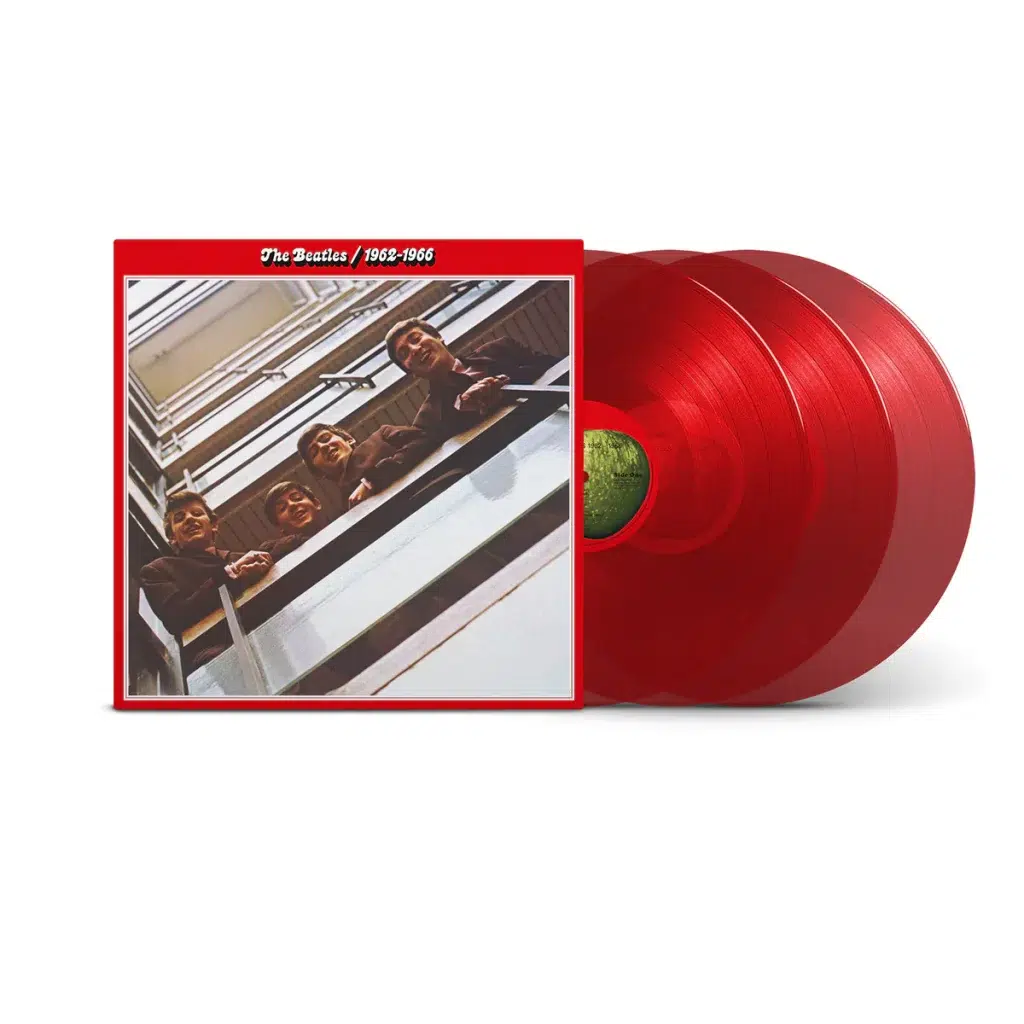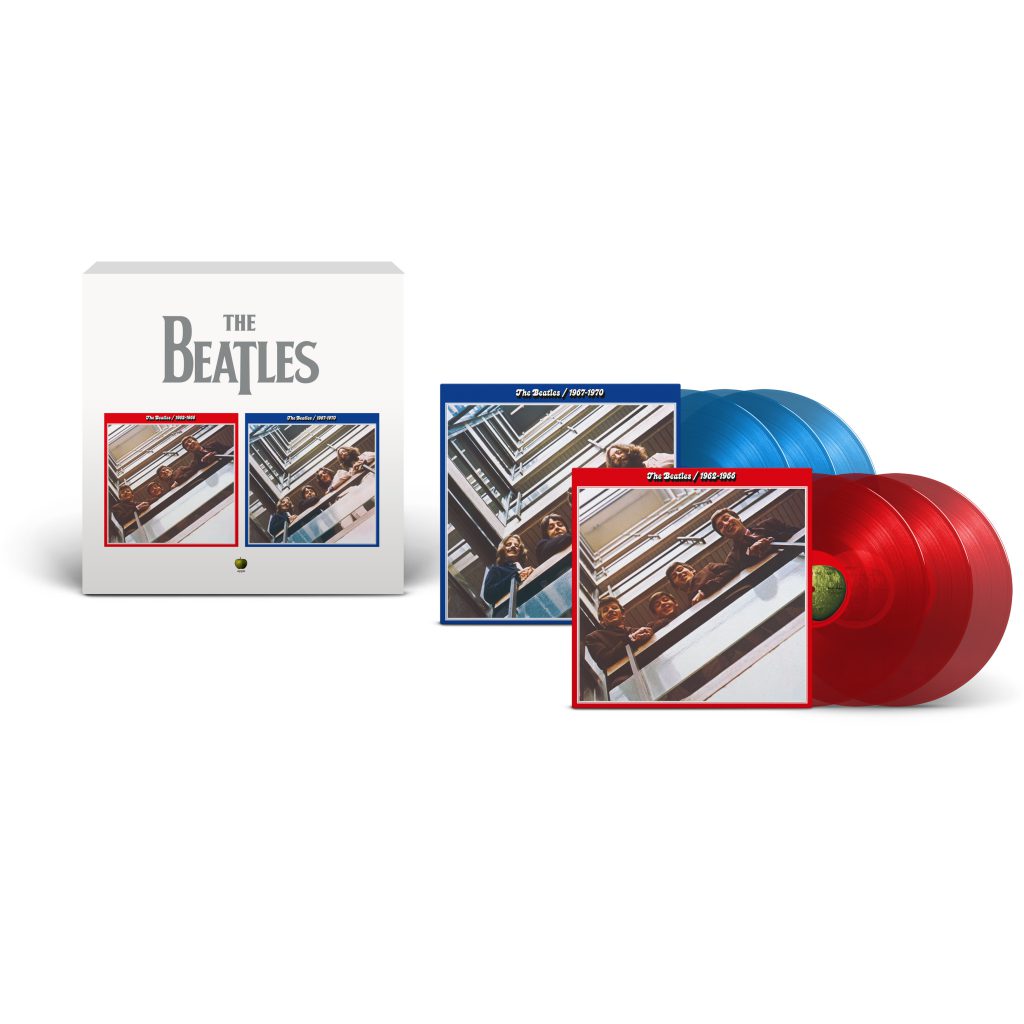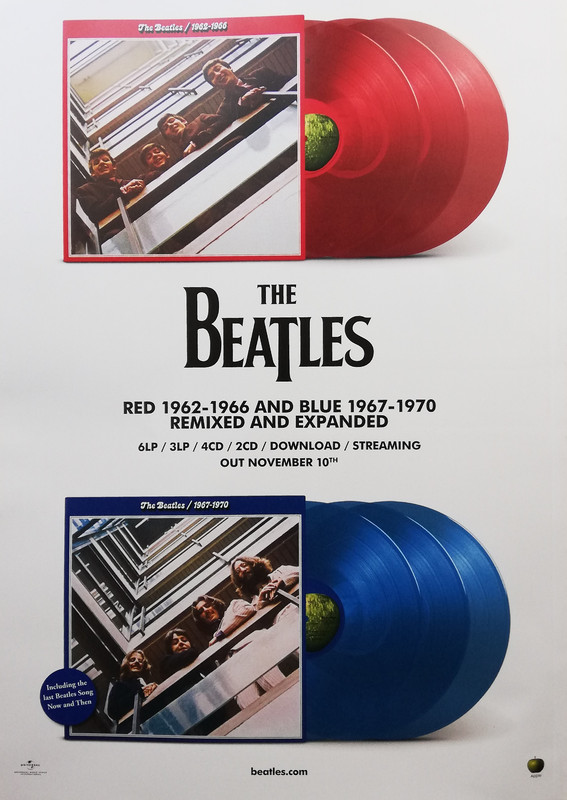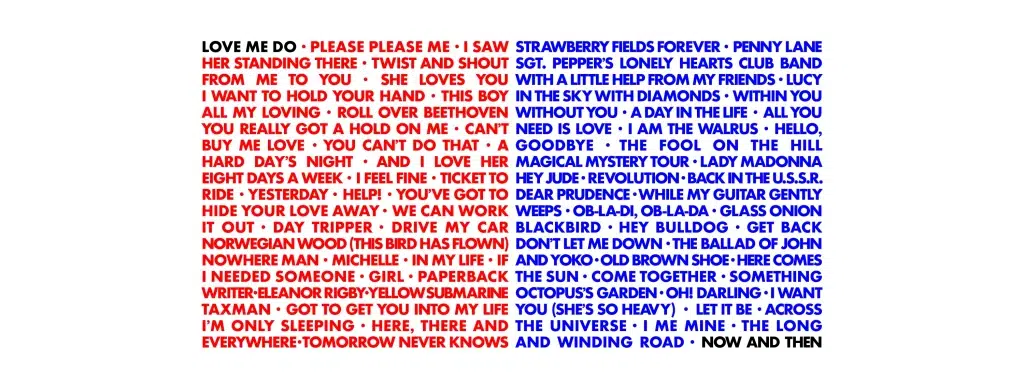- Release date:
- Nov 10, 2023
Timeline
More from year 2023
Related articles
Spread the love! If you like what you are seeing, share it on social networks and let others know about The Paul McCartney Project.
Hide track details
Track list
Side 1
1.
2:23 • Studio version • E • Stereo • 2023 stereo mix
- Paul McCartney :
- Bass, Vocals
- Ringo Starr :
- Drums, Tambourine
- John Lennon :
- Acoustic rhythm guitar, Harmonica, Vocals
- George Harrison :
- Acoustic rhythm guitar
- George Martin :
- Producer
- Norman Smith :
- Recording engineer
- Giles Martin :
- Mixing engineer, Sound producer
- Paul Hicks :
- Mixing engineer
- Sam Okell :
- Mixing engineer
- Miles Showell :
- Mastering
- Emile De La Rey :
- Head of machine learning at wingnut film
- Session Recording:
- Sep 11, 1962
- Studio :
- EMI Studios, Studio Two, Abbey Road
- Session Mixing:
- 2022 - 2023 ?
- Studio :
- EMI Studios, Abbey Road
2.
3.
4.
5.
6.
7.
Side 2
1.
2.
3.
4.
5.
Side 3
2.
3.
4.
5.
6.
Side 4
1.
3.
5.
2:18 • Studio version • D • Stereo • 2022 stereo mix
- Paul McCartney :
- Backing vocals, Bass, Electric guitar, Lead vocals
- Ringo Starr :
- Drums
- John Lennon :
- Backing vocals, Tambourine
- George Harrison :
- Backing vocals, Electric guitar
- George Martin :
- Producer
- Geoff Emerick :
- Recording engineer
- Giles Martin :
- Mixing engineer, Producer
- Sam Okell :
- Mixing engineer
- Session Recording:
- Apr 13, 1966
- Studio :
- EMI Studios, Studio Three, Abbey Road
- Session Overdubs:
- Apr 14, 1966
- Studio :
- EMI Studios, Studio Three, Abbey Road
- Session Mixing:
- Circa 2022
- Studio :
- EMI Studios, Abbey Road
6.
2:06 • Studio version • H • Stereo • 2022 stereo mix
- Paul McCartney :
- Vocals
- John Lennon :
- Harmony vocals
- George Harrison :
- Harmony vocals
- George Martin :
- Producer
- Geoff Emerick :
- Recording engineer
- Giles Martin :
- Mixing engineer, Producer
- Tony Gilbert :
- Violin
- Sidney Sax :
- Violin
- John Sharpe :
- Violin
- Jürgen Hess :
- Violin
- Stephen Shingles :
- Viola
- John Underwood :
- Viola
- Derek Simpson :
- Cello
- Norman Jones :
- Cello
- Sam Okell :
- Mixing engineer
- Miles Showell :
- Mastering
- Session Recording:
- Apr 28, 1966
- Studio :
- EMI Studios, Studio Two, Abbey Road
- Session Overdubs:
- Apr 29, 1966
- Studio :
- EMI Studios, Studio Three, Abbey Road
- Session Overdubs:
- Jun 06, 1966
- Studio :
- EMI Studios, Studio Three, Abbey Road
- Session Mixing:
- Circa 2022
- Studio :
- EMI Studios, Abbey Road
7.
2:38 • Studio version • G • Stereo • 2022 stereo mix
- Paul McCartney :
- Backing vocals, Bass
- Ringo Starr :
- Drums, Vocals
- John Lennon :
- Acoustic guitar, Backing vocals
- George Harrison :
- Backing vocals, Tambourine
- George Martin :
- Backing vocals, Producer
- Geoff Emerick :
- Backing vocals, Recording engineer, Tape loop (marching band)
- Giles Martin :
- Mixing engineer, Producer
- Mal Evans :
- Backing vocals, Bass drum
- Neil Aspinall :
- Backing vocals
- Pattie Boyd / Harrison :
- Backing vocals, Laughter
- Brian Jones :
- Backing vocals, Ocarina, Sound effects (clinking glasses)
- Marianne Faithfull :
- Backing vocals
- Alf Bicknell :
- Backing vocals, Sound effects (rattling chains)
- Sam Okell :
- Mixing engineer
- Miles Showell :
- Mastering
- Unknown musician(s) :
- Brass band
- John Skinner :
- Sound effects (chains in bathtub)
- Terry Condon :
- Sound effects (chains in bathtub)
- Session Recording:
- May 26, 1966
- Studio :
- EMI Studios, Studio Three, Abbey Road
- Session Overdubs:
- Jun 01, 1966
- Studio :
- EMI Studios, Studio Two, Abbey Road
- Session Mixing:
- Circa 2022
- Studio :
- EMI Studios, Abbey Road
Side 5
1.
2.
4.
5.
6.
Side 6
1.
2.
2:29 • Studio version • E • Stereo • 2022 stereo mix
- Paul McCartney :
- Bass, Electric guitar, Lead vocals
- Ringo Starr :
- Drums, Tambourine
- John Lennon :
- Organ, Rhythm guitar
- George Harrison :
- Electric guitar
- George Martin :
- Producer
- Geoff Emerick :
- Recording engineer
- Giles Martin :
- Mixing engineer, Producer
- Eddie Thornton :
- Trumpet
- Ian Hamer :
- Trumpet
- Les Condon :
- Trumpet
- Alan Branscombe :
- Tenor saxophone
- Peter Coe :
- Tenor saxophone
- Sam Okell :
- Mixing engineer
- Miles Showell :
- Mastering
- Session Recording:
- Apr 08, 1966
- Studio :
- EMI Studios, Studio Two, Abbey Road
- Session Overdubs:
- Apr 11, 1966
- Studio :
- EMI Studios, Studio Two, Abbey Road
- Session Overdubs:
- May 18 and Jun 17, 1966
- Studio :
- EMI Studios, Studio Two, Abbey Road
- Session Mixing:
- Circa 2022
- Studio :
- EMI Studios, Abbey Road
3.
3:00 • Studio version • F • Stereo • 2022 stereo mix
- Paul McCartney :
- Backing vocals, Bass
- Ringo Starr :
- Drums
- John Lennon :
- Acoustic rhythm guitar, Vocals
- George Harrison :
- Backing vocals, Lead guitar
- George Martin :
- Producer
- Geoff Emerick :
- Recording engineer
- Giles Martin :
- Mixing engineer, Producer
- Sam Okell :
- Mixing engineer
- Miles Showell :
- Mastering
- Session Recording:
- Apr 27, 1966
- Studio :
- EMI Studios, Studio Three, Abbey Road
- Session Overdubs:
- Apr 29, May 5, May 6, 1966
- Studio :
- EMI Studios, Studio Three, Abbey Road
- Session Mixing:
- Circa 2022
- Studio :
- EMI Studios, Abbey Road
4.
Written by George Harrison
2:38 • Studio version • D • Stereo • 2022 stereo mix
- Paul McCartney :
- Backing vocals, Bass, Lead guitar
- Ringo Starr :
- Cowbell, Drums, Tambourine
- John Lennon :
- Backing vocals
- George Harrison :
- Lead guitar, Vocals
- George Martin :
- Producer
- Geoff Emerick :
- Recording engineer
- Giles Martin :
- Mixing engineer, Producer
- Sam Okell :
- Mixing engineer
- Miles Showell :
- Mastering
- Session Recording:
- Apr 21, 1966
- Studio :
- EMI Studios, Studio Two, Abbey Road
- Session Overdubs:
- Apr 22, 1966
- Studio :
- EMI Studios, Studio Two, Abbey Road
- Session Overdubs:
- May 16, 1966
- Studio :
- EMI Studios, Studio Two, Abbey Road
- Session Mixing:
- Circa 2022
- Studio :
- EMI Studios, Abbey Road
5.
2:24 • Studio version • E • Stereo • 2022 stereo mix
- Paul McCartney :
- Acoustic guitar, Bass, Finger clicks, Vocals
- Ringo Starr :
- Drums, Finger clicks
- John Lennon :
- Backing vocals, Finger clicks
- George Harrison :
- Backing vocals, Finger clicks, Lead guitar
- George Martin :
- Producer
- Geoff Emerick :
- Recording engineer
- Giles Martin :
- Mixing engineer, Producer
- Sam Okell :
- Mixing engineer
- Miles Showell :
- Mastering
- Session Recording:
- Jun 14, 1966
- Studio :
- EMI Studios, Studio Two, Abbey Road
- Session Recording:
- Jun 16, 1966
- Studio :
- EMI Studios, Studio Two, Abbey Road
- Session Overdubs:
- Jun 17, 1966
- Studio :
- EMI Studios, Studio Two, Abbey Road
- Session Mixing:
- Circa 2022
- Studio :
- EMI Studios, Abbey Road
6.
2:57 • Studio version • F • Stereo • 2022 stereo mix
- Paul McCartney :
- Bass, Piano, Tape loops
- Ringo Starr :
- Drums, Tambourine, Tape loops
- John Lennon :
- Organ, Tape loops, Vocals
- George Harrison :
- Lead guitar, Sitar, Tamboura, Tape loops
- George Martin :
- Producer
- Geoff Emerick :
- Recording engineer
- Giles Martin :
- Mixing engineer, Producer
- Sam Okell :
- Mixing engineer
- Miles Showell :
- Mastering
- Session Recording:
- Apr 06, 1966
- Studio :
- EMI Studios, Studio Three, Abbey Road
- Session Overdubs:
- Apr 07, 1966
- Studio :
- EMI Studios, Studio Three, Abbey Road
- Session Overdubs:
- Apr 22, 1966
- Studio :
- EMI Studios, Studio Two, Abbey Road
- Session Mixing:
- Circa 2022
- Studio :
- EMI Studios, Abbey Road
About
From TheBeatles.com, October 26, 2023:
THE BEATLES’ 1962-1966 (‘THE RED ALBUM’) AND 1967-1970 (‘THE BLUE ALBUM’) COLLECTIONS EXPANDED, MIXED IN STEREO & DOLBY ATMOS FOR 2023 EDITION RELEASES OUT NOVEMBER 10
On November 10, The Beatles’ 1962-1966 (‘The Red Album’) and 1967-1970 (‘The Blue Album’) collections will be released in 2023 Edition packages by Apple Corps Ltd./Capitol/UMe.
Since their first incarnations appeared 50 years ago, these albums have introduced successive generations to The Beatles’ music. Now, both collections’ tracklists have been expanded, with all the songs mixed in stereo and Dolby Atmos. New 4CD and 180-gram 6LP vinyl collections pair ‘Red’ and ‘Blue’ in slipcased sets. The UK single version of “Love Me Do” now kicks off 1962-1966 (2023 Edition) and “Now And Then” is featured on 1967-1970 (2023 Edition) to complete the career-spanning collections.
From The Beatles 1962–1966 (2023 Edition): 3LP Red Album (Exclusive Red Vin – The Beatles:
RELEASE DATE: 10 NOVEMBER, 2023
The Beatles: 1962-1966 (2023 Edition) – 3LP Limited Colour
Remixed and Expanded: ‘Red’ has 12 additional tracks, including for the first time some of George Harrison’s earliest songs and some classic Beatles versions of R&B and rock ‘n’ roll hits that were so influential on the band.
The 3LP collection now contains 38 tracks, the set’s 12 newly added tracks are collected on its 3rd LP. With an insert containing new sleeve notes by journalist and author John Harris, the new 1962 – 1966 collection is a joyous celebration of The Beatles’ timeless musical legacy.
Half speed master. 180g pressing. Limited Edition Red vinyl. Store Exclusive
What was the thinking behind the expansion of the Red and Blue albums?
That kind of stemmed from “Now and Then,” really. You know, we finished “Now and Then,” and then there was the thought about, OK, it can’t go on an album. What are we going to put it on?
There was a thought about trying to respect people’s listening tastes. And the fact that they’ve changed — and the No. 1s, for example, don’t really reflect the most popular Beatles songs that people are listening to.
Then, we realized it was the 50th anniversary of Red and Blue. For a whole generation — much older than you, my generation — the Red and Blue albums have this sort of gravitas behind them. I know all the tracklistings; even though I think I was 3, when they came out, we had them at home.
So, we decided to do the Red and Blue albums — which took quite a long time, because there was quite a lot of stuff to do on them.
Giles Martin – From GRAMMY.com, October 26, 2023
People weren’t expecting the Red and Blue collections necessarily to come out at this time. They — we — thought it might be a deluxe “Rubber Soul” next, working backward from what you last did with “Revolver.” And sometimes people disparage hits collections. Bbut I just know from my personal experience, when those albums came out in 1973 when I was a kid, I so immersed myself in them it was like a religious conversion, to the Beatles.
Yeah — for me, too. I think we’re that of generation. There’s certain generations where it’s like, “the Red and Blue albums, what are they?” And then there’s generations going, “Yeah, I know every song in the track listing on the Red and Blue albums.” There was a lot of thought behind the process of doing this, like obviously there’s going to be. But the conversations were, in essence, about this: the interesting thing about the Beatles’ catalog is that the tracks that are listened to by the new generations now aren’t necessarily the tracks that are on the No. 1s album (“1s,” a compilaton that came out in 2000), for example. The most streamed track is “Here Comes the Sun,” and that’s not on the No. 1s. So in a way, this compilation has a relevance to it (for younger people). But also, as stand-alone albums for people like you and me, us crusty blokes, who are of that generation… […]
With the tracks that were added for both “1962-66” and “1967-70,” whoever made those decisions, they’re interesting decisions. It’s not entirely just the biggest hits that weren’t on the original 1973 LPs. Also, on vinyl, it’s interesting that there is a sequence that’s adheres to the original vinyl sides, and puts all the added songs on additional discs, whereas the CD and digital versions place everything in chronological order — the original and newly added tracks.
Well, with the added tracks, where they come from, the original thought process was: “OK, how do we respect and honor what people listen to these days?” And a lot of the tracks you have as the added tracks are tracks that are really popular now, for whatever reason. But we sort of changed tack on that a little bit in the creation process. We were like: “Well, you can’t make a playlist” (of just the most-consumed songs). Do you know what I mean? That’s the world we’re in, but that doesn’t make any sense. It’s not very Beatles, as well. Even nowadays, we’re meant to be leading, as opposed to just going, “We looked at the (most played songs) and these are the greatest hits in the playlist.” It wouldn’t be very Beatles. So we ended up in the Red and Blue [instead of starting from scratch with an all-new, data-driven track list].
Giles Martin – From variety.com, November 2, 2023
I asked Giles Martin about de-mixing and remixing the early, pre-Revolver songs: What is the end goal of that method with those relatively simple recordings? What was gained in service of the song and performance?
[Let’s] talk about the intent. It’s like saying, ‘Black and white films were intended to be in black and white.’ That was only because color didn’t exist. To answer the question ‘Can you do this?’: Of course, and this is what we’re [doing], in a groundbreaking way … We are taking tracks that in some cases—for example, ‘She Loves You’—are purely mono, and managing to separate the source instruments from those tracks, and then creating a new [stereo] mix. You have to be careful that you’re being musical about this, as natural as possible, but if you were in the room with The Beatles at the studios, you wouldn’t be listening in mono, you’d be listening to a band in a room. And that’s essentially what we’re trying to create. That was the intent, honestly, in those days when my father and Norman Smith were recording The Beatles. They were trying to capture the live sound of a band. So I think that’s what we’re celebrating with these early mixes, [using] the [de-mixing] technology.
Given that perspective, I wondered why he had chosen to keep drums mostly or entirely in one speaker, guitars in the other, on many of the Rubber Soul-era songs.
If we were to mix with a set of written rules, the mixes probably wouldn’t be very musical. It’s really based on taste. In ‘Drive My Car,’ the drums are still left, but they’re not as hard left as they were on the original, I don’t think, and that’s to give room for the guitar and piano. In ‘Norwegian Wood,’ the voices are in the middle, the drums are coming I think on the right-hand side, which makes sense because you’ve got guitars going on.
The interesting thing is, The Beatles were so economical with what they played, compared to modern day recordings. You quite often have a guitar, bass, and drums, and a vocal, and so if you’re thinking about the sound field of the three instruments, if you put the drums in the middle, and the guitar on the right-hand side, and then the bass on the left-hand side, it’ll sound right-heavy because bass doesn’t have much direction. So therefore, you have to put the drums slightly off to one side in order to create a stereo field. And the voices, we always try to put the voice in the middle.
Giles Martin – From Stereophile.com, October 26, 2023

“The Beatles: 1962-1966 (2023 Edition) – 3LP Limited Colour” is also available as a bundle with “The Beatles: 1967-1970 (2023 Edition)- 3LP Limited Colour“.



Last updated on February 25, 2024


Contribute!
Have you spotted an error on the page? Do you want to suggest new content? Or do you simply want to leave a comment ? Please use the form below!